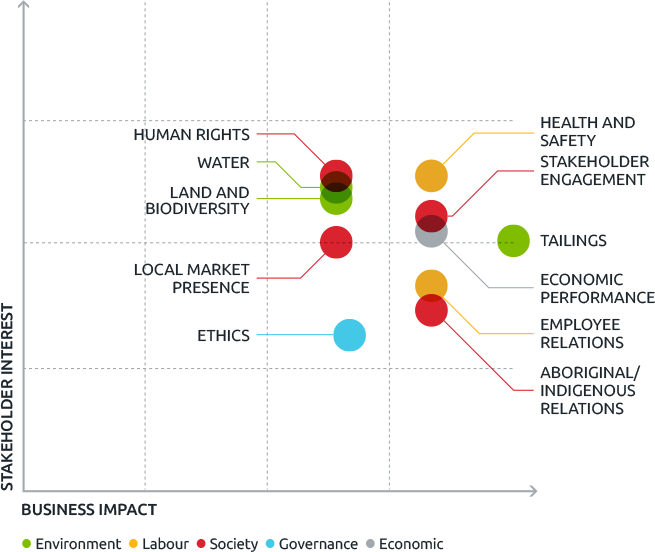 2014 Annual and CSR Report
2014 Annual and CSR Report

In 2014, we undertook a combined materiality, hazard and aspect assessment to guide both our CSR reporting and our management priorities. This assessment considered the environment, health, safety and community (EHSC) issues (or aspects) that are most significant to Hudbay in terms of business impact and the degree of stakeholder interest.
Facilitated by a third party, and using our 2011 materiality review and the new GRI G4 guidelines as a starting point, the assessment involved:
Eleven priority issues were identified through the materiality assessment. The aspect boundaries apply to all Hudbay operations globally. Click on the issue in the diagram below for details on how it is being managed and 2014 performance.

This table indicates how material topics align with G4 aspects, which are reported in the GRI index:
| Material topics | GRI (G4) aspects |
|---|---|
| Ethics |
|
| Human rights |
|
| Stakeholder engagement |
|
| Aboriginal/indigenous relations |
|
| Health and safety |
|
| Employee relations |
|
| Economic performance |
|
| Local market presence |
|
| Land and biodiversity |
|
| Water |
|
| Tailings |
|
Additional issues were identified as relevant to Hudbay and important within Hudbay’s management framework, but not as high priorities in terms of broad stakeholder interest or specific business risk. These topics included corporate governance, energy and climate change, air emissions, and ethics and business practices. Supply chain sustainability was identified as relevant with respect to local suppliers and on-site contractors, but of lower priority with respect to major international suppliers. These issues are all included in Hudbay’s management processes, but are not emphasized in this report and, in accordance with GRI guidance, are not identified in the GRI index of this report.
The materiality review was conducted on the initial boundary assumption of activities and facilities within Hudbay’s management control (as described in the Our Company section of this report). Participants in the review process were then asked for cases in which boundary limits should be adjusted for specific aspects. The exceptions that were agreed to be appropriate based on stakeholder expectations and business risk are as follows: